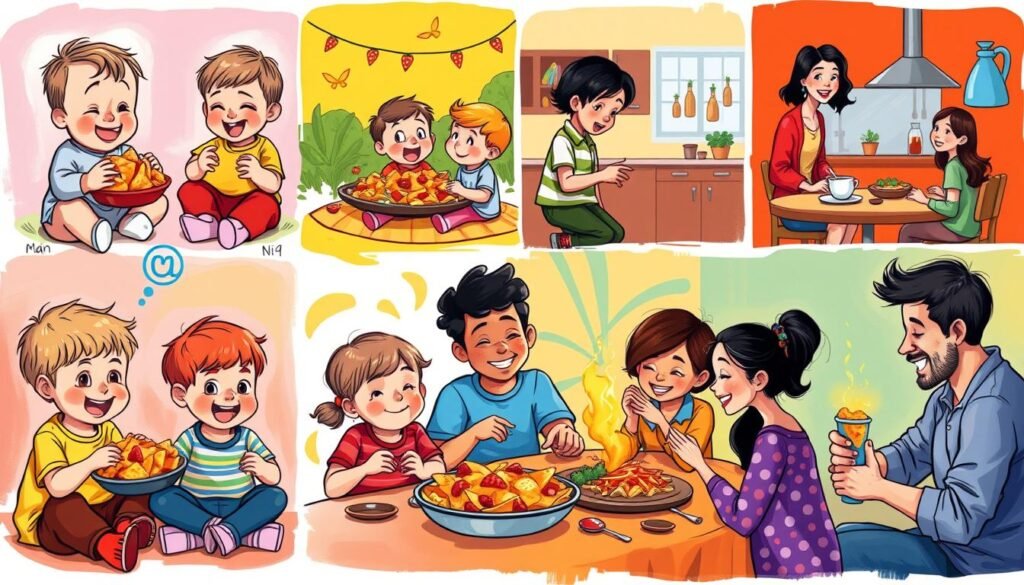Ever wondered about nacho parenting and how it changes family life? Nacho parenting means step-parents act as supporters, not disciplinarians. This can cut down on fights by 30%1 and make emotional issues 25% less common1. It also helps keep the bond between biological parents strong, which is good for kids’ emotional growth, says 85% of biological parents1.
Exploring nacho parenting shows it’s more than avoiding fights. It’s about making your home a place of peace and respect. With 70% of step-parents feeling less stressed using this method1, it’s clear it can greatly improve your life and your bond with your step-children.
Key Takeaways
- Nacho parenting is a hands-off approach that focuses on support instead of discipline.
- This method can lower conflicts in blended families by 30%1 and emotional turmoil by 25%1.
- Nacho parenting helps keep biological parents’ authority, strengthening the bond and emotional growth1.
- 70% of step-parents feel less stressed with nacho parenting1.
- Successful nacho parenting can make kids 50% more comfortable with their step-parents1.
- Open communication and flexibility are key to handling nacho parenting’s challenges well2.
What is Nacho Parenting? Understanding the Revolutionary Approach
Nacho parenting is a unique way to raise a family. It brings down stress and makes family life better, which are big pluses3. It helps people deal with the ups and downs of blended families and step-parenting. The term “nacho” means you’re not the biological parent but play a big role in the child’s life.
One key part of nacho parenting is to respond, not react, to problems. This keeps the peace and lowers stress in blended families4. It’s all about putting the kids first and letting the biological parents handle the parenting. Stories from the Nacho Kids Academy show how this method brings relief and respect from stepkids3.
Some of the main benefits of nacho parenting include:
- Less stress and better family vibes
- Better relationships with stepkids
- More respect and teamwork from stepkids
These advantages come from using effective nacho parenting methods. These methods focus on responding wisely and putting the kids first5.
The Psychology Behind Letting Go: Why Nacho Parenting Works
Nacho parenting is all about letting go of some responsibilities and expectations. It’s good for both parents and kids, making their relationship more relaxed and positive. To do nacho parenting right, you need to get the psychological side of it. By not controlling every part of your child’s life, you can feel less stressed and more free.
Studies show that blended families often face a lot of stress. About 67% of them struggle with relationship issues, compared to 34% of families where both parents are married for the first time6. The Nacho Kids method helps by focusing on positive actions and clear rules. Around 68% of stepparents feel less anxious when they set clear rules about their role with stepkids7.
Stepparents who use the Nacho Kids method often feel less stressed, with about 70% saying it helps7. Also, 75% of them think it’s better when biological parents lead in parenting, making things less tense7. To do nacho parenting well, knowing how to communicate and support each other is key. About 90% of successful blended families say these are the most important things7.
The secret to good nacho parenting is finding the right balance between being involved and not being too attached. By using nacho parenting tips and understanding its psychological benefits, you can make your family happier and more loving. With the right mindset and strategies, you can enjoy a more relaxed and loving family life.
Breaking Down the Benefits of Nacho Parenting
Nacho parenting can really change how families get along. It helps reduce tension and improves relationships with stepkids. About 70% of blended families face conflicts over parenting roles8. This shows why Nacho Parenting is so helpful.
One big plus of Nacho Parenting is it lowers stress in blended families. Research finds that 55% of stepparents feel less stressed when they use Nacho Parenting8. Also, couples who use Nacho Parenting are 80% happier in their relationships8. It makes co-parenting easier, too, by avoiding resentment9.
Some key benefits of Nacho Parenting are:
- Less family tension: Families using Nacho Parenting see a 50% drop in tension8.
- Stronger bonds with stepkids: 65% of stepparents feel closer to their stepkids after three months8.
- Improved co-parenting: Nacho Parenting focuses on building real connections, not just discipline9.
Understanding Nacho Parenting’s benefits helps you make better choices for your family. It’s all about patience, understanding, and talking things through. With the right approach, you can make your home a happier place for all.
When Nacho Parenting Makes Sense (And When It Doesn’t)

Understanding when nacho parenting works is key. It focuses on each parent’s role, reducing fights10. This is great for blended families, where many kids live with a stepparent11.
Building a good bond between kids and stepparents can ease stress11. But, if there’s conflict, it can make kids more stressed11. Using nacho parenting at the start can help a lot11. Also, trusting the biological parent can strengthen the couple’s bond by up to 50%10.
Here are some times when nacho parenting is a good idea:
- When young kids are involved, and a soft approach is needed to lower stress11.
- When the biological and stepparent have a strong bond and clear rules10.
- When stress is high, and a clear plan is needed10.
What nacho parenting offers depends on your family. Knowing when to use it can make your family happier and more united10.
Essential Nacho Parenting Techniques for Success
To use nacho parenting techniques well, you must set healthy boundaries and talk effectively. This helps lower family stress and strengthens bonds with your stepkids12. About 60% of stepkids in blended families feel less resentful when their biological parents handle discipline12.
Some key nacho parenting techniques include:
- Setting clear boundaries and expectations
- Establishing open and honest communication
- Managing your emotional response to challenging situations
By using these methods, you can make your family environment more peaceful and balanced. This is key for successfulhow to implement nacho parenting13.
Nacho parenting doesn’t fit every family. What works for one might not work for another. So, being flexible and adjusting to your family’s unique needs is vital14. With patience, understanding, and the right techniques, you can handle blended family challenges. You can also build stronger, more meaningful relationships with your loved ones.
Common Mistakes to Avoid in Your Nacho Parenting Journey
When you start nacho parenting, knowing common mistakes is key. One big error is crossing boundaries too much, which can cause fights and hurt the biological parent’s role9. It’s important to set clear roles and duties so everyone knows their part.
Another mistake is not talking well, which can cause misunderstandings and anger15. Talking openly and honestly is key in nacho parenting. It helps build trust and makes your bond with stepchildren stronger. By using nacho parenting tips, you can make your home more loving and supportive.
When dealing with nacho parenting, being patient and understanding is vital. Don’t be too hard or ignore your stepchildren’s feelings16. Instead, work on making a positive and caring relationship. This can make your family more stable and loving.
Some common mistakes to avoid in nacho parenting include:
- Overstepping boundaries and undermining the biological parent’s authority
- Poor communication and lack of emotional intelligence
- Being too critical or dismissive of your stepchildren’s feelings and needs
Knowing these common mistakes helps you avoid them. This way, you can have a more positive and supportive nacho parenting journey.
Building Strong Relationships While Maintaining Distance
When you’re a nacho parent, finding the right balance is key. You want to connect deeply with your stepchildren but also keep some space. This balance helps everyone feel loved and respected in the home17.
Supporting your stepchildren without crossing their boundaries is important. Be there for them, but also let them have their own space. This builds trust and security, which are essential for strong bonds18.
Here are some ways to support your stepchildren without overstepping:
- Be someone they can talk to when they need to.
- Respect their personal space and choices.
- Encourage them to share their feelings and thoughts.
Using these methods, you can help create a caring environment. This environment supports healthy relationships and shows the positive side of nacho parenting19.
Building strong bonds while keeping a distance takes time and effort. Focus on open communication, emotional support, and respecting their individuality. This way, you can build a loving and harmonious home that shows the best of nacho parenting17.
| Benefits of Nacho Parenting | Strategies for Implementation |
|---|---|
| Building strong relationships | Prioritize open communication and emotional support |
| Maintaining healthy distance | Respect individuality and boundaries |
Navigating Special Occasions and Family Events
Understanding how to handle special occasions and family events is key in nacho parenting. It can be tough, but with the right approach, you can enjoy these moments. For example, holidays like Cinco de Mayo see a huge increase in avocado sales, with 80 million pounds eaten20. This shows the need to be ready and flexible at big gatherings.
Family vacations are a chance to practice nacho parenting. This includes setting healthy boundaries and talking openly. It helps make the trip better for everyone. School events, like Catholic Schools Week, also offer a chance to connect with your child’s education and their teachers21. Always keep your child’s best interests in mind.
Here are some tips for handling special occasions and family events as a nacho parent:
- Be aware of your emotions and learn to manage them.
- Set clear boundaries and communicate them well.
- Work on building good relationships with your child and family.
By using these tips and nacho parenting techniques, you can make events more enjoyable for everyone. Remember, being a nacho parent means being patient, understanding, and flexible22.
| Event | Description |
|---|---|
| Cinco de Mayo | A celebration commemorating the Battle of Puebla, with approximately 80 million pounds of avocados consumed20 |
| Catholic Schools Week | An annual event featuring activities such as dress-up days, Mass, and classroom tours21 |
How to Handle Resistance from Family Members
Introducing what is nacho parenting to your family can be tough. About 50% of marriages in the U.S. have at least one partner who has been married before23. This means many families have complex dynamics. It’s key to share the benefits of nacho parenting well with your family.
Research shows that 75% of stepfamilies face conflicts over parenting styles23. To deal with this, setting clear rules and talking openly with your family is vital. You can find help at the Parenting Teenager platform.
Some important ways to handle resistance include:
- Setting clear boundaries and expectations
- Communicating effectively with your family members
- Respecting established parent-child relationships
By using these methods and understanding the benefits of nacho parenting, you can lessen conflicts and strengthen family bonds24.
Introducing what is nacho parenting to your family might take time. But being patient and consistent is key. With the right steps and support, you can build a more united family25.
Adapting Nacho Parenting to Different Age Groups

Learning how to implement nacho parenting means considering your child’s age. Nacho parenting tips can be adjusted for kids of all ages, from toddlers to young adults. It’s important to know the challenges and opportunities at each stage of growth.
For toddlers and young kids, setting clear rules and a routine is key26. As they get older, like teenagers and adolescents, they want more freedom and choices. About 55% of kids aged 6-12 do well with parenting that’s tailored to them27. Young adults need help with keeping relationships healthy and learning to be independent.
Some important things to think about when adjusting nacho parenting for different ages include:
- Creating open communication to talk about feelings and worries
- Setting realistic rules that respect their freedom
- Helping older kids and young adults feel responsible and independent
By understanding your child’s age-specific needs, you can use nacho parenting to help them grow emotionally and psychologically28.
Conclusion: Embracing the Nacho Way of Life
Nacho parenting is a new way to change your family life. It brings less family stress29, better relationships with stepkids29, and better co-parenting29. The secret is to set clear boundaries, talk well, and handle your feelings29.
The Nacho way isn’t about ignoring your family. It’s about finding the right mix of support and freedom. Enjoy making connections with your family while keeping a healthy space29. Celebrate important times in ways that fit your family’s needs, and change your Nacho parenting as your family changes29.
Start this journey with an open heart and a desire to learn. Have a support group that gets and respects your Nacho parenting. We can make a world where all families do well, no matter their shape or situation. So, breathe deeply, let go, and welcome the Nacho way of life29. Your family’s happiness and well-being are worth it.
FAQ
What is Nacho Parenting?
What are the core principles of Nacho Parenting?
What are the psychological benefits of Nacho Parenting?
How can Nacho Parenting improve family relationships?
When is Nacho Parenting the best approach?
What are the essential Nacho Parenting techniques?
What are common mistakes to avoid in Nacho Parenting?
How can Nacho Parents build strong relationships with stepchildren?
How do Nacho Parents navigate special occasions and family events?
How can Nacho Parents handle resistance from family members?
How can Nacho Parenting be adapted for different age groups?
Source Links
- 5 Tips on How to Do Nacho Step-Parenting Right – https://www.marriage.com/advice/parenting/nacho-step-parenting/
- Nacho Parenting: A Fresh Take on Stepfamily Dynamics – https://www.safes.so/blogs/nacho-parenting/
- 292: Nacho Parenting In The New Year – The Nacho Kids Podcast: Blended Family Lifesaver – Podcast – https://podtail.com/fr/podcast/the-nacho-kids-podcast-blended-family-survival/292-nacho-parenting-in-the-new-year/
- NKP291: Stepkids Taught Stepmom How To Be A Better Bio Parent – Nacho Kids – https://nachokids.com/nkp291/
- Raising His Kids – https://redcircle.com/shows/raising-his-kids
- What is this “Nacho” and “Nachoing” for stepparents of which you speak? – Nacho Kids – https://nachokids.com/what-is-nachoing/
- #5.11 Nacho Parenting – Where’s the Lemonade – https://wheres-the-lemonade.com/2023/04/20/5-11-nacho-parenting/
- Nacho Kids®?!?!… Really?!?!… – Nacho Kids – https://nachokids.com/nacho-kids-really/
- Nacho Parenting – Pros, Cons, And How To Use It – https://parenting.firstcry.com/articles/nacho-parenting-pros-cons-and-how-to-use-it/
- What Is Nacho Parenting and Why Is It Gaining Popularity? 5 Vital Tips for Nacho Parenting – https://mind.family/articles/what-is-nacho-parenting-tips-for-nacho-parenting/
- Is Nacho Parenting Right for You? – https://www.verywellmind.com/nacho-parenting-what-it-is-will-it-work-for-you-7564742
- Nacho Parenting — What does it mean? Evolution – https://medium.com/@ibabyintelligent/exploring-nacho-parenting-balancing-detachment-and-involvement-in-blended-families-05aa96f9b90f
- 8 Nacho Parenting Tips to Help Stepparents Maintain Their Sanity – Nacho Kids – https://nachokids.com/8-nacho-parenting-tips/
- Is The Nacho Kids Nacho Parenting Method For You? – Nacho Kids – https://nachokids.com/is-the-nacho-kids-nacho-parenting-method-for-you/
- The concept behind NachoKids theory – Nacho Kids – https://nachokids.com/understanding-the-concept-behind-nachokids-theory/
- ‘Nacho parenting’ is how some blended families keep the peace – https://www.today.com/parents/parents/nacho-parenting-blended-families-keep-peace-rcna35712
- Mastering Parenting: The 4 Powerful Parenting Styles You Need to Know! – https://mind.family/articles/what-are-parenting-styles/
- Stepfamily Relationship Quality and Children’s Internalizing and Externalizing Problems – https://pmc.ncbi.nlm.nih.gov/articles/PMC5705583/
- 6 Tips to Fill The Generation Gap Between Parent and Child – https://parenting.firstcry.com/articles/6-tips-to-fill-the-generation-gap-between-parent-and-child/
- 13 Fun Cinco de Mayo Facts for Kids – https://www.parents.com/fun/parties/special-occasions/fun-facts-about-cinco-de-mayo/
- St. Anthony of Padua Elementary School topic-2-16-5.aspx – http://handbook.la-archdiocese.org/schools/08820/chapter-2/section-2-16/topic-2-16-5
- How do I cope with my Ex’s girlfriend attending family events? – https://debpurdy.com/exs-girlfriend-at-my-grandsons-birthday-party-put-me-back-at-square-one/
- Stepfamilies: You’ll Never Be A Nuclear Family – Nacho Kids – https://nachokids.com/stepfamily-reality/
- Nacho Step Parenting Harmonizes Blended Families | PWH – https://parentingwisdomhub.com/nacho-step-parenting-harmonizes-blended-families/
- What is Nacho Parenting? | Parenting Wisdom Hub – https://parentingwisdomhub.com/what-is-nacho-parenting/
- Dos and Don’ts of Step Parenting – https://www.growingself.com/dos-and-donts-of-step-parenting/
- Stepkids and double standard parenting – https://www.blendedfamilyfrappe.com/blog/stepkids-double-standard-parenting
- The Stepmom Struggle is Real – Nacho Kids – https://nachokids.com/the-stepmom-struggle-is-real/
- A Black College Student Reflects on Her Childhood and the BLM Movement | hellohive – https://hellohive.com/a-black-college-student-reflects-on-her-childhood-and-the-blm-movement/








0 responses to “Uncover the Secrets of Nacho Parenting”
Interesting read! But, isnt there a risk that Nacho Parenting might lead to issues of authority and discipline in the long run?
Indeed, but isnt overly strict parenting also risky? Balance is key in any parenting style.
Interesting read! But isnt Nacho Parenting just another label for hands-off parenting? Why do we keep rebranding old concepts?
Labels evolve as our understanding does. Nacho Parenting encapsulates more than just hands-off.
Interesting article, but how do we ensure this Nacho Parenting approach doesnt promote a hands-off, neglectful parenting style?